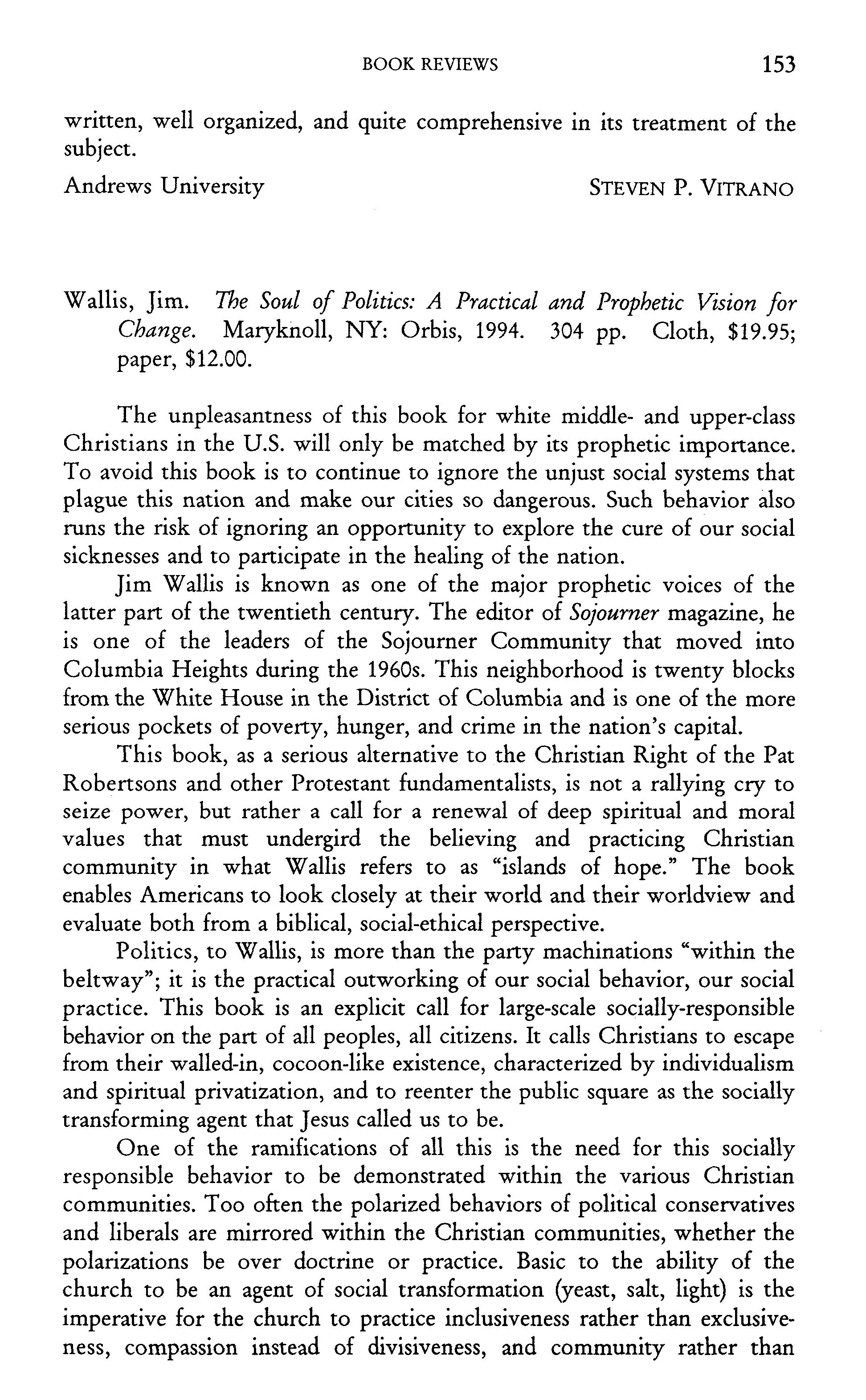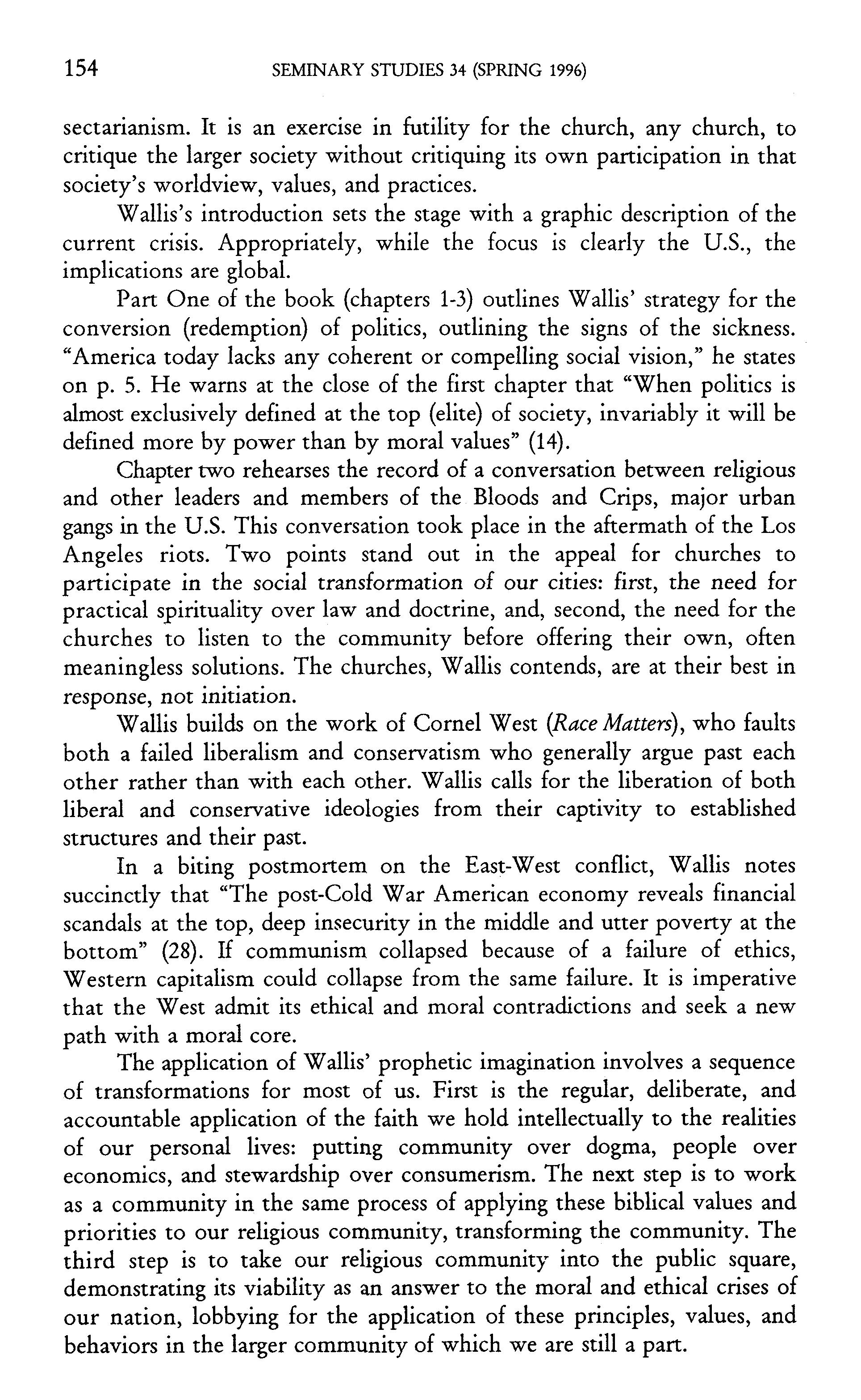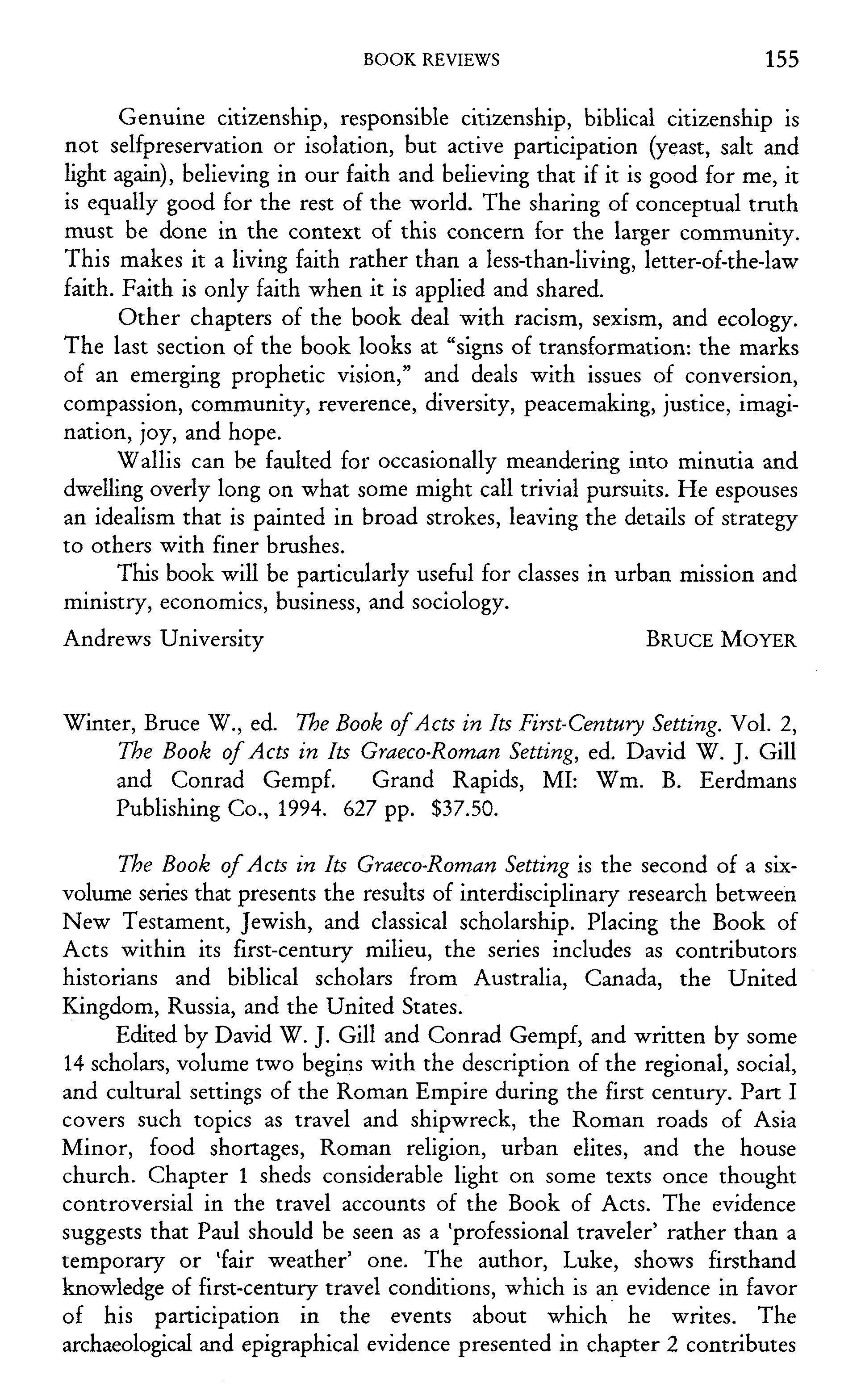written, well organized, and quite comprehensive in its treatment of the subject.
Andrews University STEVENP. VITRANO

Wallis, Jim. The Soul of Politics: A Practical and Prophetic Vision for Change. Maryknoll, NY: Orbis, 1994. 304 pp. Cloth, $19.95; paper, $12.00.
The unpleasantness of this book for white middle- and upper-class Christians in the U.S. will only be matched by its prophetic importance. To avoid this book is to continue to ignore the unjust social systems that plague this nation and make our cities so dangerous. Such behavior also runs the risk of ignoring an opportunity to explore the cure of our social sicknesses and to participate in the healing of the nation.
Jim Wallis is known as one of the major prophetic voices of the latter part of the twentieth century. The editor of Sojourner magazine, he is one of the leaders of the Sojourner Community that moved into Columbia Heights during the 1960s. This neighborhood is twenty blocks from the White House in the District of Columbia and is one of the more serious pockets of poverty, hunger, and crime in the nation's capital.
This book, as a serious alternative to the Christian Right of the Pat Robertsons and other Protestant fundamentalists, is not a rallying cry to seize power, but rather a call for a renewal of deep spiritual and moral values that must undergird the believing and practicing Christian community in what Wallis refers to as "islands of hope." The book enables Americans to look closely at their world and their worldview and evaluate both from a biblical, social-ethical perspective. Politics, to Wallis, is more than the party machinations "within thebeltwayn; it is the practical outworking of our social behavior, our social practice. This book is an explicit call for large-scale socially-responsible behavior on the part of all peoples, all citizens. It calls Christians to escape from their walled-in, cocoon-like existence, characterized by individualism and spiritual privatization, and to reenter the public square as the socially transforming agent that Jesus called us to be.
One of the ramifications of all this is the need for this socially responsible behavior to be demonstrated within the various Christian communities. Too often the polarized behaviors of political conservatives and liberals are mirrored within the Christian comLunities, whether the polarizations be over doctrine or practice. Basic to the ability of the church to be an agent of social transformation (yeast, salt, light) is the imperative for the church to practice inclusiveness rather than exclusiveness, compassion instead of divisiveness, and community rather than

sectarianism. It is an exercise in futility for the church, any church, to critique the larger society without critiquing its own participation in that society's worldview, values, and practices.
Wallis's introduction sets the stage with a graphic description of the current crisis. Appropriately, while the focus is clearly the U.S., the implications are global.
Pan One of the book (chapters 1-3) outlines Wallisy strategy for the conversion (redemption) of politics, outlining the signs of the sickness. "America today lacks any coherent or compelling social vision," he states on p. 5. He warns at the close of the first chapter that "When politics is almost exclusively defined at the top (elite) of society, invariably it will be defined more by power than by moral values" (14).
Chapter two rehearses the record of a conversation between religious and other leaders and members of the Bloods and Crips, major urban gangs in the U.S. This conversation took place in the aftermath of the Los Angeles riots. Two points stand out in the appeal for churches to participate in the social transformation of our cities: first, the need for practical spirituality over law and doctrine, and, second, the need for the churches to listen to the community before offering their own, often meaningless solutions. The churches, Wallis contends, are at their best in response, not initiation.
Wallis builds on the work of Cornel West (Race Matters), who faults both a failed liberalism and conservatism who generally argue past each other rather than with each other. Wallis calls for the liberation of both liberal and conservative ideologies from their captivity to established structures and their past.
In a biting postmortem on the East-West conflict, Wallis notes succinctly that "The post-Cold War American economy reveals financial scandals at the top, deep insecurity in the middle and utter poverty at the bottom" (28). If communism collapsed because of a failure of ethics, Western capitalism could collapse from the same failure. It is imperative that the West admit its ethical and moral contradictions and seek a new path with a moral core.
The application of Wallis' prophetic imagination involves a sequence of transformations for most of us. First is the regular, deliberate, and accountable application of the faith we hold intellectually to the realities of our personal lives: putting community over dogma, people over economics, and stewardship over consumerism. The next step is to work as a community in the same process of applying these biblical values and priorities to our religious community, transforming the community. The third step is to take our religious community into the public square, demonstrating its viability as an answer to the moral and ethical crises of our nation, lobbying for the application of these principles, values, and behaviors in the larger community of which we are still a part.
Genuine citizenship, responsible citizenship, biblical citizenship is not selfpreservation or isolation, but active participation (yeast, salt and light again), believing in our faith and believing that if it is good for me, it is equally good for the rest of the world. The sharing of conceptual truth must be done in the context of this concern for the larger community. This makes it a living faith rather than a less-than-living, letter-of-the-law faith. Faith is only faith when it is applied and shared.
Other chapters of the book deal with racism, sexism, and ecology. The last section of the book looks at "signs of transformation: the marks of an emerging prophetic vision," and deals with issues of conversion, compassion, community, reverence, diversity, peacemaking, justice, imagination, joy, and hope.
Wallis can be faulted for occasionally meandering into minutia and dwelling overly long on what some might call trivial pursuits. He espouses an idealism that is painted in broad strokes, leaving the details of strategy to others with finer brushes.
This book will be particularly useful for classes in urban mission and ministry, economics, business, and sociology.
Andrews University

BRUCEMOYER
Winter, Bruce W., ed. The Book of Acts in Its First-Century Setting. Vol. 2, The Book of Acts in Its Graeco-Roman Setting, ed. David W. J. Gill and Conrad Gempf. Grand Rapids, MI: Wm. B. Eerdmans Publishing Co., 1994. 627 pp. $37.50.
The Book of Acts in Its Graeco-Roman Setting is the second of a sixvolume series that presents the results of interdisciplinary research between New Testament, Jewish, and classical scholarship. Placing the Book of Acts within its first-century milieu, the series includes as contributors historians and biblical scholars from Australia, Canada, the United Kingdom, Russia, and the United States.
Edited by David W. J. Gill and Conrad Gempf, and written by some 14 scholars, volume two begins with the description of the regional, social, and cultural settings of the Roman Empire during the first century. Pan I covers such topics as travel and shipwreck, the Roman roads of Asia Minor, food shortages, Roman religion, urban elites, and the house church. Chapter 1 sheds considerable light on some texts once thought controversial in the travel accounts of the Book of Acts. The evidence suggests that Paul should be seen as a 'professional traveler' rather than a temporary or 'fair weather' one. The author, Luke, shows firsthand knowledge of first-century travel conditions, which is an evidence in favor of his participation in the events about which he writes. The archaeological and epigraphical evidence presented in chapter 2 contributes
